Dipavali - The Festival of Lights
- Details

Why do we celebrate Dipavali, and in what mood is it celebrated by Vrajavasis?
Dipavali means 'a time of happiness.' When Lord Rama defeated Ravana and reached Ayodhya, a big Dipavali festival was performed there...
Rays of The Harmonist - Kartik 2011 Edition
- Details

This Kartika, The Rays of The Harmonist team humbly presents the printed edition of "Entering Nitya-lila", the concluding transcendental pastimes of Sri Srimad Bhaktivedanta Narayana Gosvami Maharaja. Apart from above pictorial report, this edition's featured articles are entitled "The Real Significance of the Pastime of Illness Manifested by the Maha-bhagavata" and "The Avirabhava and Tirobhava Saktis"...
With Greed In The Center
- Details
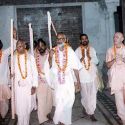
Abhista-bhava-mayi: Whatever practices we execute at the time of our sadhana (the practice executed to attain our goal) will be the same at the time of sadhya (the goal of life, the stage of siddhi, perfection). Sadhakas remember Krsna, Govinda, now, at the time of their sadhana, and they will do so in siddha-sarira (spiritual form as a gopi-manjari) as well. Both remembrances are the same, but one is unripe and the other will be ripe. The subject of the mood will never change, just as kirtana will never be changed, whether in the stage of sadhana or siddha. The sadhakas' absorption in their constitutional mood is called abhista-bhava-mayi.
Guru Tattva and the Real Disciple
- Details

Those who follow strongly the life and teachings of their Gurudeva, from their heart, are really disciples. Those who have taken initiation from Parama-pujyapada Srila Svami Maharaja but are not following his teachings, are not truly disciples. Those who are not following or practicing may have been outwardly initiated by him, but they are not real disciples. On the other hand, those who have not taken initiation from him but are totally following – they deserve the qualities to be true devotees...
Sri Guru’s Spiritual Form
- Details

This is the third of the three important slokas discussed by Srila Visvanatha Cakravarti Thakura in his Rag-vartma-candrika:
sravanotkirtanadini vaidhi-bhakty uditani tu
yany angani ca tanyatra vijneyani manisibhih
Calling Us To Govardhana
- Details

We are very lucky that by the causeless mercy of our Gurudeva, Gauranga, Nityananda Prabhu, and Radha-Vinoda-bihari we have now completed our parikrama of Vrndavana, Madhuvana, Talavana, Kumudavana, and Bahulavana, and then Bhadravana, Bhandiravana, Matavana, Baelvana, Lohavana, and Mahavana under the guidance of Vaisnavas.
Srila Sanatana Gosvami - Vilap Kusmanjali Verse 6
- Details
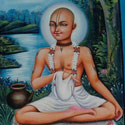
I take shelter of my lord and master, Sri Sanatana Gosvami, who is an ocean of compassion and who always feels sorry for the suffering of others. Although I was unwilling and blinded by ignorance, he diligently made me drink the nectar of devotion laced with renunciation.
To Be Covered By Sweetness
- Details
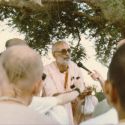
As Lalita trains Srimati Radhika in this way [for Radhika’s naocturnal meeting with Sri Krsna], Rupa Manjari watches, and our guru in this world, as sakhi-manjari in that world, also watches.
About Songs and So On
- Details

Brahma told Narada, Narada told Vyasa, and Vyasa told Sukadeva Gosvami. The knowledge is coming in parampara. By this we can know the real explanation of Srimad-Bhagavatam and the Upanisads, and that bhakti is the fruit of all the Upanisads, Vedanta, and so on. The guru-parampara has manifested this in this world, so you should know it. If you don't know all these things, then vraja-rasa-bhakti will not come to you...
Manasi Ganga And The Secret Of Giriraja Govardhana
- Details

We have come here to Manasi Ganga, which is like the mouth of Sri Giriraja Govardhana. His shape resembles that of a cow, or a peacock, and the lower extremity at Puchari (or Punchari) is like the raised tail of the peacock or the raised hindquarters of the cow. At this end are Radha Kunda and Syama Kunda, which are like the eyes of the peacock. Sometimes, when a peacock is dancing, it will raise its back very high and gracefully bend its long neck back towards the stomach...
Illuminating the Path to Ragatmika-bhakti
- Details
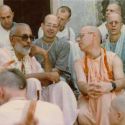
This surrender and complete dedication of the heart to guru is called tadatmya (oneness of heart) in Sanskrit. When an iron rod is placed in fire, the qualities of the fire enter the iron. When fire permeates an iron rod it is the fire that burns other objects; it is not that the iron rod burns other objects; The iron rod may ‘consider,’ “I am fire,” in the sense that the qualities of the iron have become one with the qualities of the fire; it now does the work of fire.
The Goal - Vilap-kusumanjali
- Details

In this world we have a guru and we are his disciples, but in raganuga-bhakti (internally) the guru is like a friend. Visrambhena gurau seva. In the spiritual realm, there is no formal relation of guru and disciple as there is in this world. Srila Raghunatha dasa Gosvami used to address Srila Rupa Gosvami as guru, and he respected him as such. Inwardly, however, he saw him as a sakhi, as Rupa-manjari, as he will further reveal in the third verse...
Sri Vraja-Mandala Parikrama At Govardhana
- Details
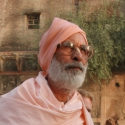
Today we are here at Govardhana. Giriraja Govardhana is very kind; he is causelessly merciful. I came here for the first time in 1947 with my Gurudeva, Sri Srimad Bhakti Prajnana Kesava Gosvami Maharaja. At that time we were engaged in the performance of Dvaraka parikrama, and we came here briefly while on that parikrama. Since then I have done Vrndavana Parikrama every year for the last fifty-five years...
Deep Teachings at Gambira - II
- Details

We have come to this very sacred place called Sri Gambhira, the palace residence of Kasi Misra, who offered it to Sri Caitanya Mahaprabhu. This place was given to Sri Caitanya Mahaprabhu on the request of the king, who said, "Sri Caitanya Mahaprabhu is Krsna Himself. I want Him to stay here." And it was so managed...
On Raganuga-bhakti
- Details

Srila Bhaktivedanta Narayana Gosvami Maharaja: What is a manjari? We have heard about kamala-manjaris and mango-manjaris. Any creeper or good flower has manjaris. Although the manjari appears first and then the flower, the manjari is always located above the flower. When a bee comes to sit on the flower and drink its honey, the manjaris tremble, being overjoyed.
How to Enter Raganuga-bhakti
- Details
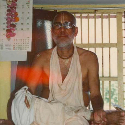
In this Raga Vartma Candrika, Srila Visvanatha Cakravarti Thakura tells us what he has realized about Sri Sri Radha-Krsna’s anuraga by the grace of Sri Caitanya Mahaprabhu and Srila Rupa Gosvami. Anuraga refers to that stage of prema which comes just before mahabhava. Within prema comes sneha, then mana, pranaya, raga, and then anuraga...
Page 3 of 47

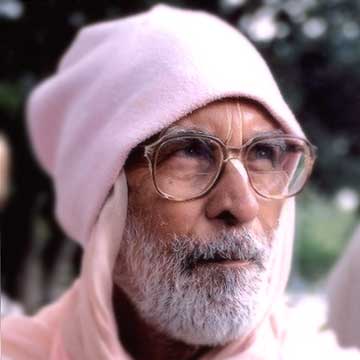





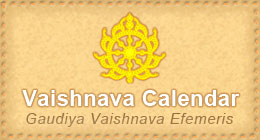


 by Śrīla Bhaktisiddhānta Sarasvatī Ṭhākura Prabhupāda
by Śrīla Bhaktisiddhānta Sarasvatī Ṭhākura Prabhupāda



